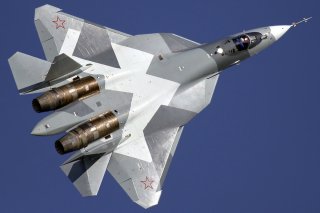Flying Alongside the Su-57, Russia’s Grom Wingman Drone Is a Killer
Aside from acting as a swarm drone carrier, the Grom UAV can is designed as a robust combat platform.
Here's What You Need to Remember: The Su-57 was also confirmed to pair with the S-70 Okhotnik-B, a stealth-capable multipurpose drone from the same family of Russian next-generation UAV’s as Grom. It is possible that Grom is being developed as an alternate loyal wingman choice for missions requiring swarm drone capability.
Fresh details have emerged concerning the new, next-generation Russian combat drone that was previously described as the “loyal wingman” to the Su-57 fifth-generation fighter.
The manufacturer of the upcoming Grom (Russian for “thunder”) unmanned aerial vehicle (UAV), Kronstadt, gave a far-reaching interview to the Russian outlet TASS earlier this week, noting that it will be able to control a swarm of ten smaller Molniya (“lightning”) drones. These Molniya drones, added Kronstadt, can be operated in strike or reconnaissance configurations: “Reconnaissance drones are capable of flying back. Strike drones, as in the case with loitering munitions, are kamikaze UAVs. Molniya drones will constantly interact with each other and the carrier drone,” said the Kronshtadt representative.
“Molniya drones constantly exchange data among themselves. It is possible to alter an assignment for each member of the swarm,” Kronstadt explained. “They can transfer leader roles and are interchangeable. Artificial intelligence allows a group of drones to fulfil its assignment without constant communications with the carrier aircraft.”
Grom was unveiled, alongside a slew of other attack and reconnaissance drones, at Russia’s ARMY-2020 military exhibition. Though it was previously known that the Grom UAV can operate a drone swarm, Kronstadt’s interview has shed light on the Molniya drone’s operational flexibility and ability to carry out tasks without direct orders from the lead aircraft.
Aside from acting as a swarm drone carrier, the Grom UAV can is designed as a robust combat platform. The UAV, which appears to have a length of 13.8 meters and a wingspan of around ten meters, will have a payload capacity of 1.3 tons, take-off weight of seven tons, and operational range of around 800 km. Grom’s four hardpoints can accept a wide range of weapons, including the Kh-38 air-air-surface missile, KAB-250 and KAB-500 guided bombs, and a new “item 85 smart air bomb.” The Grom UAV not only bears a striking outward resemblance to the U.S.-made Kratos XQ-58 Valkyrie, but offers some of the same capabilities.
The Grom drone can deliver “precision strikes” against enemy infrastructure or high-value targets without putting its accompanying aircraft at risk. Additionally, the Molniya drones could be able to saturate and potentially even eliminate certain types of air defense systems. They can also perform unspecified electronic warfare tasks in conjunction with the head aircraft.
Grom’s interoperability with the Su-57 was not explicitly mentioned in Kronstadt’s recent TASS interview—in fact, the manufacturer did not discuss compatibility with any specific aircraft. However, Kronstadt’s Head Designer Nikolai Dozhdkov previously confirmed to Russian media that Grom will be compatible with both the Su-57 and Su-35 fighters.
The Su-57 was also confirmed to pair with the S-70 Okhotnik-B, a stealth-capable multipurpose drone from the same family of Russian next-generation UAV’s as Grom. It is possible that Grom is being developed as an alternate loyal wingman choice for missions requiring swarm drone capability. Whereas Okhotnik-B is scheduled to enter service in 2025, no development or production timeline has been provided for Grom.
Mark Episkopos is the new national security reporter for the National Interest. This article first appeared earlier this year.
Image: Wikipedia.

